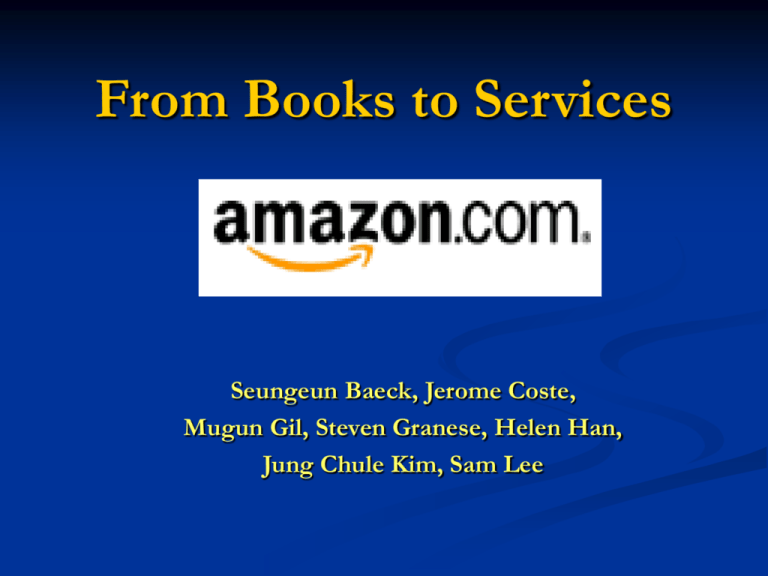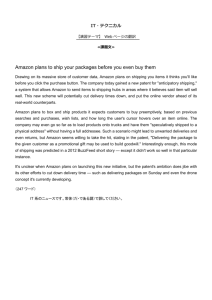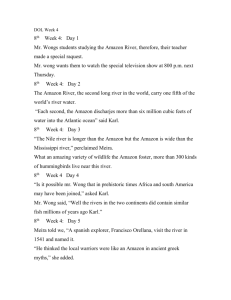Team 1
advertisement

From Books to Services Seungeun Baeck, Jerome Coste, Mugun Gil, Steven Granese, Helen Han, Jung Chule Kim, Sam Lee Overview Introduction Internal Analysis External Analysis Competitive Structure Industry Structure Summary Analysis Business Model Financials Value Chain IT SWOT Conclusion Q&A Introduction Key Facts Amazon.com is headquartered in Seattle, Washington and founded by Jeff Bezos in 1995, who graduated from Princeton University with Computer Science and Electrical Engineering degree. Source: AnnOnline Introduction History Highlights 1995 1997 1998 1999 - Book IPO Music, DVD, Video, Germany, UK Toy, electronic, home improvement, software, and video games; Amazon.com Auctions 2000 - Online bargain stores, France, Japan 2001 - Partnership with Target and Circuit City, Office Deport, acquired Egghead.com, first quarterly profit of 5.8 millions in 4th quarter 2002 - Third-party content incorporation Business Model Mission & Vision Mission: “To become Earth’s most customercentric company” Vision: To become Earth’s biggest store Source: Annual Stockholder Meeting, 5/28/03 Business Model Value Proposition Source: Annual Stockholder Meeting, 5/28/03 Business Model Revenue Model Retail: Virtual Merchant Model Service: Market Creator Model: Marketplace, Zshops, and Amazon.com Auctions Affiliate Model: Merchant@ and Merchant.com programs Source: Amazon.com, Target.com Financial Stock Price Five year performance Range:15.06 - 47.75 Market Cap:18.47B Source: Finance Yahoo EPS :-0.23 Financial Sales vs. Operating Expense (in Billions) 5 3.93 4 2.76 3 3.12 1.64 2 Net Sales Operating Expense 0.61 1 0.015 0.148 0 1995 1996 1997 1998 1999 2000 2001 2002 -1 -2 -0.006-0.031-0.125 -0.72 -0.567-0.149 -1.411 Financial Interest Expense vs. Net Loss (in Billions) 0.4 0.2 0 -0.2 1998 1999 2000 2001 2002 -0.4 -0.6 -0.8 -1 -1.2 -1.4 -1.6 Interest Exp. Net Loss Financial Sales Business Unit Sizing 2002 27% Projected to grow to 33% of Total Sales 8% 6% 15% International 44% BMVD ETK Services Shipping Suppliers • JIT inventory • Virtual inventory stored in database • Relatively low overhead • Track consumer demand • IT maintenance • 24/7 world wide operation Value Chain Primary Activities Operations Distribution • Routing optimization • Customer integration with suppliers Customers •Automated customer service Value Chain Supporting Activities Primary Activities Supporting Activities Infrastructure High quality IT infrastructure; Major focus on cutting costs Human Resource Expensive technical talent; High Sales/Employee ratio Technology Huge Database, High R&D Spending Procurement In house, online purchasing software IT Original Focus: Spending Significant Investment in Information Technology Spent over $1 Billion on IT Recruit the top computer scientists and engineers Pioneer in innovative e-tailing features “One-Click” buying Customized shopping experience Product suggestions Cross and up-selling Speedy checkout procedure Source: Business 2.0 IT New Focus: Saving Reduced IT spending from 11 to 6 cents for every dollar of sales Custom software = customized business processes Heavy reliance upon Open Source 2001: switched to all Linux servers on HP machines, which cut expenses from $71 to $54 million Linux provides many benefits Source: Business 2.0 IT Technology Spending (in millions) 300 250 200 150 100 50 0 1998 1999 2000 2001 2002 IT Becoming an IT Development Shop Created web services (XML) tools for 3rd party developers Spun off subsidiary “Amazon Services” to leverage use of their proprietary IT Retailers can access Amazon’s products (Toys R Us) Amazon can build and maintain a branded site (Target) Fastest growing part of their business Accounts for 19% or sales Possible because of brand name Source: Wired Overview Introduction Internal Analysis External Analysis Competitive Structure Industry Structure Summary Analysis Business Model Financials Value Chain IT SWOT Conclusion Q&A Competitive Structure Top e-Tailing Sites, in Terms of Unique Visitors Source: Sandeep Krishnamurthy Competitive Structure Top e-Tailing Sites in Books, Toys, Videos and Music Source: Sandeep Krishnamurthy Industry Structure Entry Barriers Suppliers (-) Internet offers direct selling (+) Amazon’s brand reduces supplier’s bargaining power (+) Little differentiation of products (+) High volume decreases suppliers’ bargaining power (+) Installed customer base creates high barrier to entry (+) Amazon services create valuable marketplaces (-) E-tailing can be replicated Industry Competitors Buyers •Barnes and Noble •Buy.com •Walmart.com •eBay (-) Strong competition on price (-) Duplication of each other’s features Threat of Substitute (-) Price search engines increases buyers’ power (+) Amazon’s features increase switching costs (-) Products available in offline stores (-) Online order, offline pickup Overview Introduction Internal Analysis External Analysis Competitive Structure Industry Structure Summary Analysis Business Model Financials Value Chain IT SWOT Conclusion Q&A Strengths Innovative in-house IT: One-click patent Large selection of virtual products Personalization of website Great search accuracy Related product matching Customer reviews Strong Brand First mover and dotcom hype Positive WOM Affiliated with other companies Huge customer database High rate of repeat customers: 78% One-stop-shopping and cross-selling High inventory turnover for books Management team stayed focused with vision Services are growing (19% of Sales as of second quarter, expected to be 33% for the year) Weaknesses Time delay distribution No exclusive accesses to primary content High COGS for products High advertising costs Difficult relationship with manufacturers Strategy used to be too vague: Get Big Fast Spreading themselves too thin No 2003 Profit Yet, but expected for Opportunities Expansion of other product groups International expansion Strategy shifts to services Merchant.com: Powered by Amazon.com Merchant@Program Auctions: C2C market creater Z-shops: B2C market creater Threats Brick & Mortar competitors are going online Existing Internet competitors Low Financial flexibility Only two major suppliers Technological innovations E-books Mp3 p2p services MPEG4 Price search engines Overview Introduction Internal Analysis External Analysis Competitive Structure Industry Structure Summary Analysis Business Model Financials Value Chain IT SWOT Conclusion Q&A Conclusion First mover in e-commerce retail industry Built a strong brand with a loyal following Struggled to make a profit Focused on reducing costs Leveraged brand to launch service model Expected to become profitable Q&A






